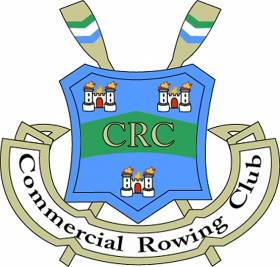Displaying items by tag: Commercial Regatta
#Rowing: Trinity won the men’s senior eight at Commercial Regatta at Islandbridge today. Commercial had divided their Championships winning eight into two crews. The rain came – at almost exactly the same time as in Saturday’s Neptune Regatta, but the full set of races were held. Neptune beat Commercial in the women’s club one eight, one of the last of a long day.
Commercial Regatta, Islandbridge, Sunday (Selected Results)
Men,
Eight – Senior: Trinity bt Commercial, 2l. Club One: UCD bt Commercial 1l. Novice: UCD B bt Trinity A 1l. Jun 18A: Neptune beat Coláiste Iognáid 1l. Jun 15: Athlone bt Coleraine GS 4l.
Four – Inter, coxed: Trinity bt Commercial 2l. Club One, coxed: Commercial B bt Neptune, canvas. Jun 18A: Col Iognaid bt New Ross 3l.
Sculling, Quadruple – Club One, coxed: Neptune bt Commercial, scratched. Novice: Commercial bt Neptune 1l. Jun 18A, coxed: Col Iognaid bt Blackrock ½ l. Jun 16, coxed: Blackrock A bt Coleraine GS 1 ½ l.
Double – Senior: Commercial/Neptune bt Neptune ½ l. Club One: King’s Hospital bt Neptune distance. Jun 18A: Neptune C bt Three Cstles B 2l. Jun 16: Blackrock bt Carlow B 3l.
Single – Inter: Sligo (G Patterson) bt Offaly (C Brady) 3l. Club One: Lagan (N Darby) bt Carrick-on-Shannon (E Djeribi) 5l. Jun 18: Carrick (F Early) bt Neptune (S Byrne) 1l.
Women
Eight – Inter: Commercial bt Trinity 3l. Club One: Neptune bt Commercial 1 ½ l. Nov: UCD A bt UCD B distance. Jun 18A: Col Iognaid bt Commercial 3l. Jun 16: Coleraine Grammar School bt Commercial 1 ½ l.
Four – Senior, coxed: Commercial A bt Commercial B 1l. Inter: Commercial B bt Commercial A, distance. Club One, coxed: UCD D bt UCD B 3l. Jun 18A, coxed: Col Iognaid bt Commercial ½ l.
Sculling, Quadruple – Club One, coxed: Neptune A bt Athlone ¾ l. Nov, coxed: Neptune bt Trinity 2l. Jun 18, coxed: Col Iognaid bt Sligo 4l. Jun 16, coxed: Commercial bt Neptune 2l.
Double – Club One: King’s Hos A bt King’s Hos B, 3l. Jun 18A: Commercial A bt Carrick-on-Shannon 3l. Jun 16: Commercial bt Athlone A 3l.
Commercial's Strength on Show at Home Regatta
#Rowing: Commercial’s strength and depth were very evident at their own regatta at Islandbridge in Dublin today. After a huge programme was worked through, many of the finals involved the host club – some with two home crews competing against each other. The Intermediate eight was one such race. In the club eight, Trinity came out on top.
Commercial Regatta, Islandbridge, Sunday (selected results)
Men
Eight – Club: Trinity bt Blackrock 5l. Inter: Commercial A bt Commercial B ½ l. Novice: UCD bt UCD B 5l. Masters: Commercial bt Neptune 1l.
Four – Sen, coxed: Commercial C bt Commercial A ½ l. Jun 18, coxed: Commercial bt Neptune 3l.
Pair – Sen: Commercial A bt Commercial B.
Sculling,
Quadruple – Novice: Commercial A bt Neptune 2l. Jun 18, coxed: Three Castles bt Commercial 4l. Jun 16, coxed: Blackrock A bt Commercial ¾ l. Club, coxed: Neptune bt King’s Hos 3 ½ l.
Novice: Commercial B bt King’s Hos 4l. Jun 16: Three Castles bt New Ross 4l.
Double – Sen: Commercial A bt Commercial B 1 ¼ l. Club: Waterford A bt Garda distance. Jun 18: Three Castles A bt Three Castles B 5l.
Single – Club One: Carrick-on-Shannon (Earley) bt Commercial (Connolly) 2 ½ l . Inter: Commercial (N Beggan) bt Commercial (J Phelan) 2l. Nov: Offaly (K Morris) bt Commercial (J Wareham) dnf. Jun 18A: New Ross (L Sutton) bt Killorglin (J McCarthy) 3 ¼ l. Jun 16: Carlow (H Slattery) and Three Castles (L Flynn) dead heat.
Women
Eight – Novice: Trinity A bt Neptune canvas. Jun 16: Carlow bt Athlone disq.
Four – Sen, coxed: Commercial C bt Commercial A 1l. Club, coxed: Commercial bt Trinity 3l. Jun 18: Commercial bt New Ross 1l. Jun 16: Commercial bt Galway scr.
Pair – Sen: Commercial C bt Commercial A 2l.
Sculling, Quadruple – Club, coxed: King’s Hos bt Killorglin 2l. Novice, coxed: Commercial B bt Neptune A 4l. Jun 18, coxed: New Ross bt Commercial 3l. Jun 16, coxed: Carlow bt Killorglin 1 ¼ l.
Double – Sen: Neptune bt Commercial 3½ l. Club: Neptune A bt UCD 3l. Jun 18: New Ross B bt Offaly dist. Jun 16: Commercial bt Killorglin 3l.
Single – Inter: Neptune (C Feerick) bt Athlone (Y Curley) 4l. Club: Garda (J Ryan) bt Neptune (E Power) dist. Nov: Commercial (S Bedair) bt Commercial (S Donnelly) dist. Club One: Garda (J Ryan) bt Neptune (E Power) distance. Jun 18A: Carrick-on-Shannon (T Duggan) bt Commercial (D O’Toole) 2 ½ l. Jun 18B: Offaly (E Dowling) bt Waterford (L Drohan) 3l. Masters: Offaly (C Nolan; C) bt Commercial (A Ryan; B) distance.
Huge Junior Participation at Commercial Regatta
#Rowing: Commercial Regatta was the biggest ever run by the club, with a huge entry from juniors in particular. Some of the top results also went the way of the host club. Trinity had to give way in the men’s intermediate eight, though in the women’s club eight they reversed the order. Scott Addison of Trinity won the men’s club single.
Commercial Regatta, Islandbridge, Sunday (Selected Results)
Men
Eight – Intermediate: Commercial bt Trinity ¾ l. Club One: Commercial B bt Commercial 2¼ l. Novice: Neptune bt UCD, disqualified. Jun 18A: Neptune bt Commercial ¾ l.
Four – Inter, coxed: Trinity bt Commercial 5l. Club One, coxed: Commercial bt Neptune 3l. Jun 18A, coxed: Commercial bt Waterford ¾ l.
Pair – Senior: Commercial B bt Commercial A 2 ½ l.
Sculling, Quadruple – Club One, coxed: Sligo bt Carlow 4l. Novice, coxed: Neptune B bt New Ross 2 ¾ l. Jun 18A, coxed: Commercial bt Waterford 4l. Jun 16, coxed: Commercial bt New Ross 5l.
Double – Senior: Commercial A bt Commercial B ¾ l. Jun 18A: Three Castles B bt Commercial , DNF. Jun 16: Killorglin bt Waterford 3ft.
Single – Intermediate: Trinity (S Addison) bt Commercial (C Carroll) 1 ¼ l. Club One: Sligo (G Patterson) bt Portadown (A Lavins) 2 ¾ l. Novice: Commercial (E Jarvis) bt New Ross (E Jones) easily. Jun 18A: Commercial (E Meehan) bt Three Castles (O Clune) 2l. Jun 16: Waterford (S O’Brien) bt Commercial (K Browne) 2l.
Women
Eight – Club One: Trinity bt Commercial. Novice: UCD bt Trinity A easily. Jun 18: Commercial A bt Commercial B ½ l. Junior 16: Athlone bt Carlow 3/4l.
Four – Club One, coxed: Commercial bt Trinity 1 ¾ l. Novice, coxed: Commercial bt UCD 1l.
Sculling, Quadruple – Club One, coxed: Commercial B bt Commercal A 1l. Novice, coxed: Commercial bt Neptune easily. Jun 18, coxed: Waterford bt Sligo A 4l. Jun 16 coxed: Commercial bt Carlow 5l.
Double – Sen: Commercial bt Portadown easily. Jun 18A: Neptune bt Sligo A 5l. Jun 16: New Ross bt King’s Hospital 5l.
Single – Club One: New Ross (J Walsh) bt Portadown (A Martin). Jun 18A: Neptune (C Feerick) bt Fermoy (A O’Sullivan) 3 ½ l. Jun 16: Offaly (E Dowling) bt New Ross (A Coughlan) 1 ¼ l.

























































